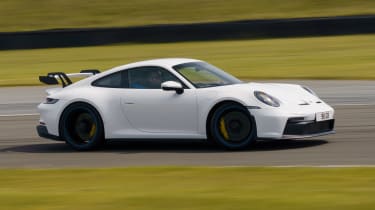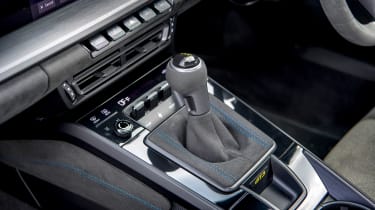Porsche 911 GT3 review – engine, gearbox and technical highlights
The GT3’s 4-litre naturally aspirated flat-six can be paired with manual and PDK transmissions
It’s tempting just to say ‘see previous generation’ for this section, because much of the drivetrain is very familiar. But that’s a good thing. Compared to the previous GT3 unit, the MDG.G 4-litre naturally aspirated flat-six engine now has individual throttle bodies and the exhaust system gains gas particulate filters, but there’s a new rear silencer that is 10kg lighter.
In other words it is all but identical to the engine found in the old 991 Speedster. Outputs are up by just 10bhp and 8lb ft to 503bhp and 347lb ft – tiny rises for a model with low figures in its group of rivals, but we’d challenge you to drive a GT3 on track and wish for an extra 200bhp.
> Litchfield Porsche 911 Carrera 4 (992) 2023 review
Both transmissions are also unique in the 992 range of the GT3 in comparison to Carrera and Turbo models. They’re older units that are a ratio down in both cases, but have been used due their lower weights and tighter packaging. The older PDK also has a physical shift lever rather than the toggle most 992s utilise, which doesn’t just give you a second option for up and downshifts, but is also the preference of Porsche GT boss Andreas Preuninger.
More reviews
Group tests
- Mercedes-AMG GT 63 v Porsche 911 Turbo S: all-wheel drive GTs go head-to-head
- Porsche 911 GT3 group test – 996 takes on 997
In-depth reviews
Reviews
- Porsche 911 S/T review – why it's our 2024 Car of the Year
- Porsche 911 Carrera (992.2) 2025 review – is the most basic 911 the sweet-spot?
- Used Porsche 911 (997, 2004-2012): review, history, specs and buying guide
- Thornley Kelham Porsche 911 European RS restomod review – worth £650k?
- Porsche 911 reimagined by Singer Classic Turbo 2024 review – the most complete restomod?
- Porsche 911 GT3 (997, 2006 - 2011): the ultimate modern classic?
A lot of effort has been put into three main areas of the chassis – weight saving, aerodynamics and suspension. Things such as the lightweight glass, new front wheels, new rear fascia, LiFePO4 battery and carbon frunk lid have all helped save weight compared to the previous-generation GT3. The end result is that, despite the 992 being a fundamentally heavier car, the latest GT3 weighs 1435kg with the PDK ’box. That’s a mere 5kg more than the old car.
The aerodynamics, however, are significantly better. The adoption of a swan-neck rear wing and an impressive rear diffuser have helped improve the downforce by 50 per cent at 124mph. However, both the wing and the front splitter are manually adjustable, and if you put them into their more aggressive settings then the car generates 385kg of downforce, which is 150 per cent more than the old car. In fact, it is more than the old RS.
Yet the biggest talking point has been the front suspension. It is now a double wishbone set-up rather than MacPherson struts – something only seen on 911 race cars before. This suspension design has allowed Porsche’s engineers to increase camber stiffness, and give the front tyres a far more consistent surface patch with the road, even under extreme cornering forces. The connections are all ball joints on the front, too, which goes some way to explaining the large amounts of road and suspension noise.
Porsche offers two OE tyre options – a Pirelli P Zero for everyday road use, or a Michelin Pilot Sport Cup 2 for track use. Such is the advance in the Cup’s wet and cold weather capability, these can be used in everyday driving, but the higher limits of grip actually make the Pirelli the tyre of choice for pure entertainment, revealing more of the GT3’s inherent balance.




